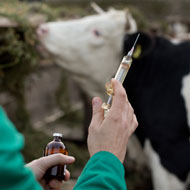Vets urged to change cattle injection method

“Based on our study findings, I strongly advise to inject all cattle in the neck where possible..."
Cattle vets and farmers are being urged to adjust their vaccination technique to reduce the risk of damaging the sciatic nerve in dairy cows.
New research from the University of Nottingham shows there is a high risk of damaging this nerve when injecting cows in the gluteal region. This is particularly true for cattle with a low body condition score, such as those that have recently calved.
In beef cattle, this area is avoided because of the value of primal cut meat; however, the site is still used for injections in dairy cattle owing to convenience.
Participants in the research - who had injected cattle in the gluteal region before - were asked to inject the left and right gluteal region in a cadaver, as if it were ‘a normal cow’. Researchers were surprised to find that 69 per cent of participants injected within 5cm of the sciatic nerve, while several injected right onto the sciatic nerve.
The study also revealed that the nerve is far wider than previously reported in textbooks. In the gluteal region, the nerve was 3.5-4.5cm wide. The depth of the nerve varied depending on the cow’s body condition, but the shallowest point between the skin surface and nerve was just 2.5cm.
Lead author Dr Wendela Wapenaar said: “Based on our study findings, I strongly advise to inject all cattle in the neck where possible; when this is not feasible and the gluteal region is used as a site for intramuscular injection then a more lateral location should be chosen.
“The region between the tuber coxae (hook bone) and the tuber ischium (pin bone) has a substantial muscle mass, and there are no underlying neurological structures at risk. This small change in injection technique may prevent nerve damage and we hope farmers and vets will take this advice on, so we may see less cows with sciatic nerve damage in the future and avoid inflicting pain unnecessarily.”



 The BSAVA has opened submissions for the BSAVA Clinical Research Abstracts 2026.
The BSAVA has opened submissions for the BSAVA Clinical Research Abstracts 2026.